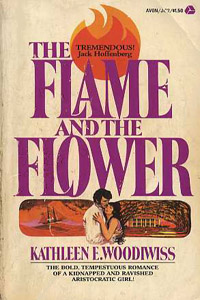
Historical romance is a broad category of mass-market fiction focusing on romantic relationships in historical periods, which Walter Scott helped popularize in the early 19th century. [1]

Historical romance is a broad category of mass-market fiction focusing on romantic relationships in historical periods, which Walter Scott helped popularize in the early 19th century. [1]
Viking books feature warriors during the Dark Ages or Middle Ages. [2] Heroes in Viking romances are stereotypically masculine men who are later "tamed" by their heroines. Most heroes are described as "tall, blonde, and strikingly handsome." [3] Using the Viking culture allows novels set in these time periods to include some travel, as the Vikings were "adventurers, founding and conquering colonies all over the globe." [3] In a 1997 poll of over 200 readers of Viking romances, Johanna Lindsey's Fires of Winter was considered the best of the subgenre. The subgenre has fallen out of style, and few novels in this vein have been published since the mid-1990s. [3]
Medieval romances are typically set between 938 and 1485. [2] Women in the medieval time periods were often considered as no more than property who were forced to live at the mercy of their father, guardian, or the king. Always a lady, the heroine must use her wits and will and find a husband who will accept her need to be independent, yet still protect her from the dangers of the times. The hero is almost always a knight who first learns to respect her and her uncommon ideas and then falls in love. Heroes are always strong and dominant, and the heroine, despite the gains she has made, is usually still in a subordinate position. However, that position is her choice, made "for the sake of and with protection from an adoring lover, whose main purpose in life is to fulfill his beloved's wishes." [4]
Tudor romances are set in England between 1485 and 1558. [2]
Elizabethan romances are set in England between 1558 and 1603, during the time of Elizabeth I. [2]
Stuart romances are set between 1603 and 1714 in England. [2]
Georgian romances are set between 1714 and 1811 in England. [2]
Regency romances are set between 1811 and 1820 in England. [2]
Victorian romances are set in England between 1832 and 1901, beginning with the Reform Act 1832 and including the reign of Queen Victoria. [2] Novels set during this period but in a fictional country may be Ruritanian novels such as those by Beatrice Heron-Maxwell. M.M. Kaye focuses on the British Raj in this period rather than England itself.
Pirate novels feature a male or female who is sailing, or thought to be sailing, as a pirate or privateer on the high seas. According to Ryan Kate, heroes are the "ultimate bad boys," who "dominate all for the sake of wealth and freedom." [5] The heroine is usually captured by the hero in an early part of the novel, and then is forced to succumb to his wishes; eventually she falls in love with her captor. On the rarer occasions where the heroine is the pirate, the book often focuses on her struggle to maintain her freedom of choice while living the life of a man. Regardless of the sex of the pirate, much of the action in the book takes place at sea. [5]
Colonial United States novels are all set in that country between 1630 and 1798. [2]
Civil War novels place their characters within the events of the American Civil War and the Reconstruction era. They may be set in the Confederacy or the Union. [2]
Western novels are set in the frontier of the United States, Canada, or Australia. [2] Unlike Westerns, where women are often marginalized, the Western romance focuses on the experiences of the female. [6] Heroes in these novels seek adventure and are forced to conquer the unknown. They are often loners, slightly uncivilized, and "earthy." [7] Their heroines are often forced to travel to the frontier by events outside their control. These women must learn to survive in a man's world, and, by the end of the novel, have conquered their fears with love. In many cases the couple must face a level of personal danger, and, upon surmounting their troubles, are able to forge a strong relationship for the future. [7]
Native American novels could also fall into the Western subgenre, but always feature Native American protagonists, historically described as "Red Indians", whose "heritage is integral to the story." [2] These romances "[emphasize] instinct, creativity, freedom, and the longing to escape from the strictures of society to return to nature." [8] Members of Native American tribes who appear in the books are usually depicted as "exotic figures" who "[possess] a freedom to be admired and envied." [8] Often the Native protagonist is struggling against racial prejudice and incurs hardships trying to maintain a way of life that is different from the norm. By the end of the novel, however, the problems are surmounted. [9] The heroes of these novels are often fighting to control their darker desires. [8] In many cases, the hero or heroine is captured and then falls in love with a member of the tribe. The tribe is always depicted as civilized, not consisting of savages, and misunderstood. [8]
When surveyed about their reasons for reading Native American romances, many readers cite the desire to learn about the beliefs, customs and culture of the Native American tribes. The novels within this subgenre are generally not limited to a specific tribe, location, or time period. Readers appreciate that native tribes "have a whole different way of life, a different way of thinking and a different way of looking at things". [9] In many cases, the tribe's love of nature is highlighted. [9]
Americana novels are set in the United States between 1880 and 1920, usually in a small town or in the Midwest. [2]
One of the first popular historical romances appeared in 1921, when Georgette Heyer published The Black Moth , which is set in 1751. It was not until 1935 that she wrote the first of her signature Regency novels, set around the English Regency period (1811–1820), when the Prince Regent ruled England in place of his ill father, George III. Heyer's Regency novels were inspired by Jane Austen's novels of the late 18th and early 19th century. Because Heyer's writing was set in the midst of events that had occurred over 100 years previously, she included authentic period detail in order for her readers to understand. [10] Where Heyer referred to historical events, it was as background detail to set the period, and did not usually play a key role in the narrative. Heyer's characters often contained more modern-day sensibilities, and more conventional characters in the novels would point out the heroine's eccentricities, such as wanting to marry for love. [11]
The modern romance genre was born in America 1972 with Avon's publication of Kathleen Woodiwiss's The Flame and the Flower , the first romance novel "to [follow] the principals into the bedroom." [12] [13] Aside from its content, the book was revolutionary in that it was one of the first single-title romance novels to be published as an original paperback, rather than being first published in hardcover, and, like the category romances, was distributed in drug stores and other mass-market merchandising outlets. [14] The novel went on to sell 2.35 million copies. [15] Avon followed its release with the 1974 publication of Woodiwiss's second novel, The Wolf and the Dove and two novels by newcomer Rosemary Rogers. One of Rogers's novels, Dark Fires sold two million copies in its first three months of release, and, by 1975, Publishers Weekly had reported that the "Avon originals" had sold a combined 8 million copies. [14] The following year over 150 historical romance novels, many of them paperback originals, were published, selling over 40 million copies. [15] Unlike Woodiwiss, Rogers's novels featured couples who travelled the world, usually were separated for a time, and had multiple partners within the book. [16]
The success of these novels prompted a new style of writing romance, concentrating primarily on historical fiction tracking the monogamous relationship between a helpless heroines and the hero who rescued her, even if he had been the one to place her in danger. [17] The covers of these novels tended to feature scantily clad women being grabbed by the hero, and caused the novels to be referred to as "bodice-rippers." [12] A Wall St. Journal article in 1980 referred to these bodice rippers as "publishing's answer to the Big Mac: They are juicy, cheap, predictable, and devoured in stupifying quantities by legions of loyal fans." [18] The term bodice-ripper is now considered offensive to many in the romance industry. [12]
In this new style of historical romance, heroines were independent and strong-willed and were often paired with heroes who evolved into caring and compassionate men who truly admired the women they loved. [19] This was in contrast to the contemporary romances published during this time, which were often characterized by weak females who fell in love with overbearing alpha males. [20] Although these heroines had active roles in the plot, they were "passive in relationships with the heroes", [21] Across the genre, heroines during this time were usually aged 16–21, with the heroes slightly older, usually around 30. The women were virgins, while the men were not, and both members of the couple were described as beautiful. [22]
In the late 1980s, historical romance dominated the romance genre. The most popular of the historical romances were those that featured warriors, knights, pirates, and cowboys. [23] In the 1990s the genre began to focus more on humor, as Julie Garwood began introducing humorous elements and characters into her historical romances. [23]
Historical romance novels are rarely published in hardcover, with fewer than 15 receiving that status each year. The contemporary market usually sees 4 to 5 times that many hardcovers. Because historical romances are primarily published in mass-market format, their fortunes are tied to a certain extent to the mass-market trends. Booksellers and large merchandisers are selling fewer mass market paperbacks, preferring trade paperbacks or hardcovers, which prevent historical romances from being sold in some price clubs and other mass merchandise outlets. [24]
In 2001, historical romance reached a 10-year high as 778 were published. By 2004, that number had dropped to 486, which was still 20% of all romance novels published. Kensington Books claims that they are receiving fewer submissions of historical novels, and that their previously published authors are switiching to contemporary. [24] [25]
{{cite journal}}: Cite journal requires |journal= (help)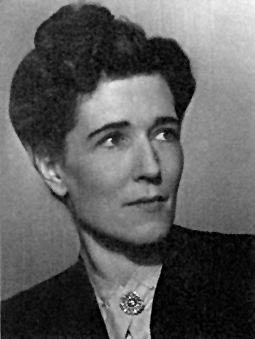
Georgette Heyer was an English novelist and short-story writer, in both the Regency romance and detective fiction genres. Her writing career began in 1921, when she turned a story conceived for her ailing younger brother into the novel The Black Moth. In 1925 Heyer married George Ronald Rougier, a mining engineer. The couple spent several years living in Tanganyika Territory and Macedonia before returning to England in 1929. After her novel These Old Shades became popular despite its release during the General Strike, Heyer determined that publicity was not necessary for good sales. For the rest of her life she refused to grant interviews, telling a friend: "My private life concerns no one but myself and my family."

Julia Pottinger, better known by her pen name, Julia Quinn, is an American author of historical romance fiction. Her novels have been translated into 41 languages and have appeared on The New York Times Bestseller List 19 times. She has been inducted into the Romance Writers of America Hall of Fame. Her Bridgerton series of novels has been adapted for Netflix by Shondaland under the title Bridgerton.

A romance novel or romantic novel is a genre fiction novel that primary focuses on the relationship and romantic love between two people, typically with an emotionally satisfying and optimistic ending. Authors who have contributed to the development of this genre include Samuel Richardson, Jane Austen, and Charlotte Brontë.

Jayne Ann Krentz, née Jayne Castle, is an American writer of romance novels. Krentz is the author of a string of New York Times bestsellers under seven different pseudonyms. Now, she only uses three names. Under her married name she writes contemporary romantic-suspense. She uses Amanda Quick for her novels of historical romantic-suspense. She uses her maiden name for futuristic/paranormal romantic-suspense writing.
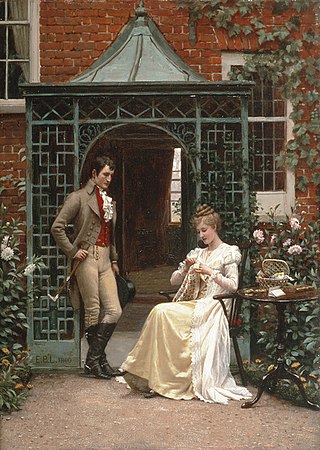
Regency romances are a subgenre of romance novels set during the period of the British Regency (1811–1820) or early 19th century. Rather than simply being versions of contemporary romance stories transported to a historical setting, Regency romances are a distinct genre with their own plot and stylistic conventions. These derive not so much from the 19th-century contemporary works of Jane Austen, but rather from Georgette Heyer, who wrote over two dozen novels set in the Regency starting in 1935 until her death in 1974, and from the fiction genre known as the novel of manners. In particular, the more traditional Regencies feature a great deal of intelligent, fast-paced dialogue between the protagonists and very little explicit sex or discussion of sex.
Mills & Boon is a romance imprint of British publisher Harlequin UK Ltd. It was founded in 1908 by Gerald Rusgrove Mills and Charles Boon as a general publisher. The company moved towards escapist fiction for women in the 1930s. In 1971, the publisher was bought by the Canadian company Harlequin Enterprises, its North American distributor based in Toronto, with whom it had a long informal partnership. The two companies offer a number of imprints that between them account for almost three-quarters of the romance paperbacks published in Britain. Its print books are presently out-numbered and out-sold by the company's e-books, which allowed the publisher to double its output.
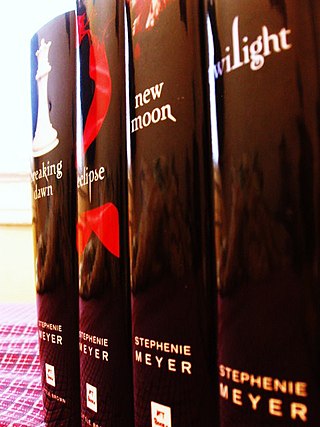
Paranormal romance is a subgenre of both romantic fiction and speculative fiction. Paranormal romance focuses on romantic love and includes elements beyond the range of scientific explanation, from the speculative fiction genres of fantasy, science fiction, and horror. Paranormal romance range from traditional romances with a paranormal setting to stories with a science fiction or fantasy-based plot with a romantic subplot included. Romantic relationships between humans and vampires, shapeshifters, ghosts, and other entities of a fantastic or otherworldly nature are common.
Kathleen E. Woodiwiss was an American novelist. She pioneered the historical romance genre with the 1972 publication of her novel The Flame and the Flower.
LaVyrle Spencer is an American best-selling author of contemporary and historical romance novels. She has successfully published a number of books, with several of them made into movies. Twelve of her books have been New York Times bestsellers, and Spencer was inducted into the Romance Writers of America Hall of Fame in 1988. She retired from writing in 1997.
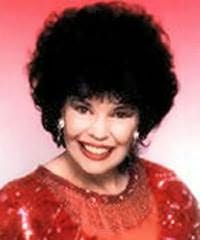
Virginia Henley, is a British-Canadian writer of historical-romance novels. She is well known for her Medieval, Renaissance and other period piece romance novels.

Lady of Quality is the final Regency romance written by Georgette Heyer. Published in the UK by The Bodley Head in 1972, and by E. P. Dutton in the U. S., it was the last of her novels to be published during her lifetime.
Rosemary Rogers was a Sri Lankan Burgher best-selling author of historical romance novels. Her first book, Sweet Savage Love, was published in 1974. She was the second romance author, after Kathleen Woodiwiss, to have her novels published in trade paperback format. Both writers found their initial success working with editor Nancy Coffey who was then with Avon Books. Rogers is considered to be one of the founders of the modern historical romance, and many of today's writers cite her writing as one of their biggest influences. She lived in California.

The Flame and the Flower is the debut work of romance novelist Kathleen E. Woodiwiss. The first modern "bodice ripper" romance novel, the book revolutionized the historical romance genre. It was also the first full-length romance novel to be published first in paperback rather than hardback.
Contemporary romance is a subgenre of contemporary and romance novels. This era of romance novels that were published after 1945 and the Second World War. Contemporary romance is generally set contemporaneously with the time of its writing. The largest of the romance novel subgenres, contemporary romance novels usually reflect the mores of their time. Heroines in the contemporary romances written prior to 1970 usually quit working when they married or had children, while those novels written after 1970 usually have, and keep, a career. As contemporary romance novels have grown to contain more complex plotting and more realistic characters, the line between this subgenre and the genre of women's fiction has blurred.
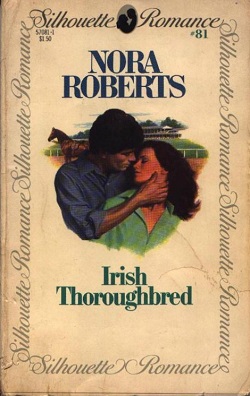
Irish Thoroughbred is American author Nora Roberts's debut novel, originally published by Silhouette in January 1981 as a category romance. Like other category romances, the novel was less than 200 pages and was intended to be on sale for only one month. It proved so popular that it was repackaged as a stand-alone romance and reprinted multiple times. Roberts wrote two sequels, Irish Rebel and Irish Rose.
Young adult romance literature is a genre of books written for teenagers. As defined by Romance Writers of America, a romance novel consists of a central love story and an emotionally satisfying ending. Early young adult romances feature a teenage protagonist, who is typically female, white, and middle-class, while books in the twenty-first century include a wider variety of protagonist.

Vision in White is the first book of the Bride Quartet series of romance novels, written by Nora Roberts. It spent two weeks atop the New York Times Bestseller List and reached number 3 on the USA Today bestseller list, marking the first time one of Roberts' books had become a bestseller in trade paperback format. A downloadable casual-play computer game based on the book was introduced by I-Play in 2010.
The Secret Diaries of Miss Miranda Cheever is a historical romance novel written by Julia Quinn. It won the 2008 RITA Award for Best Regency Historical Romance and was nominated for Romantic Times 2007 Historical Romance of the Year. The novel reached number 3 on the New York Times Bestseller List and number 4 on the USA Today bestseller list.
Sweet Starfire is a futuristic romance written by Jayne Ann Krentz and released in 1986. Krentz likened the novel to a historical romance set in another world, and its success inspired her to begin writing historical romances under the pseudonym Amanda Quick.

Western romance literature denotes a genre subset of romance literature, sometimes referred to as cowboy romance. Works within this category typically adhere to the characteristics of romance but take place in a western setting, frequently the American frontier. Though often historical, the genre is not restricted to romantic works set in the period of American settlement but extends to contemporary romantic works that centre around cowboys or other tropes of the Western genre.